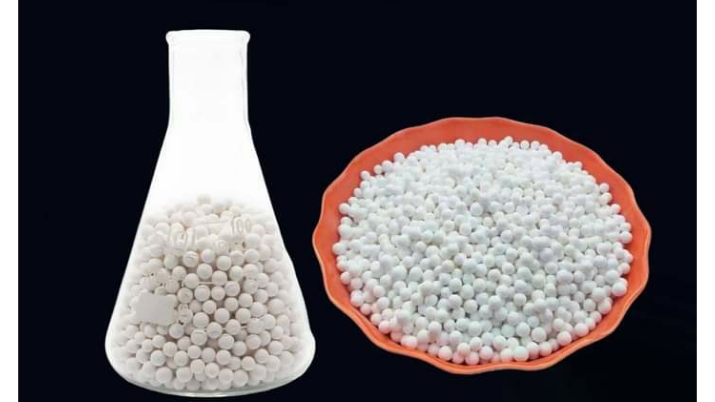Table of Contents
What Is Activated Alumina?
Activated alumina is a highly porous substance that is meticulously manufactured from aluminium hydroxide through a precise dehydroxylation process, which yields a material boasting an extremely large surface area, often exceeding 200 m²/g.

This impressive characteristic enables activated alumina to manifest its multifaceted utility as both an exceptional desiccant for adsorbing water from the ambient air and as an efficient filter for fluoride, arsenic, and selenium in the domain of potable water treatment.
The remarkable metastable forms of gamma-Al2O3 and the like dominantly compose activated alumina’s phase composition, eschewing the stable configuration of corundum (alpha-Al2O3) as a consequence of its distinctively limited chemical activity and consequently rendering it unsuitable for sorption applications.
The proliferation of “tunnel-like” pores endows activated alumina with a profoundly elevated surface-area-to-weight ratio, which serves as the bedrock of its unparalleled efficacy as an adsorptive medium.
In diverse industrial domains, activated alumina finds indispensability, operating as a vital desiccant in ensuring the impeccable dryness of gases and liquids, while concurrently serving as a discerning adsorbent in the purification of process streams essential to the petrochemical, natural gas, air separation, and water treatment industries.
Its ability to selectively adsorb and eliminate various impurities and moisture imparts an intrinsic advantage, thereby elevating its status as an indispensable tool in fostering optimal operational efficiency and product quality.
Through its unique capacity to adsorb and immobilize noxious substances like fluoride, arsenic, and selenium from drinking water, activated alumina exhibits its pivotal role as a critical safeguard in upholding public health and safety.
This exceptional filtering capability rests upon the precise control of its porous structure, facilitating the selective capture of specific contaminants while preserving essential water constituents.
Activated alumina, with its aluminium oxide (Al2O3) composition, stands as a symbol of scientific prowess and engineering acumen, exemplifying a masterful confluence of material science and industrial ingenuity. As a veritable cornerstone in the domains of desiccant and sorbent technologies, activated alumina embarks on a continuous odyssey of progress and application, continually unveiling new dimensions of utility to address the evolving needs of a technologically-driven world.
Formula Of Activated Alumina
Molecular Formula: Al2O3. N H2O (0<n≤ 0.8)
Applications
1. ADSORBENTS:
Activated alumina is a true champion in water filtration! As an adsorbent, it’s super effective at removing harmful substances from water, just like a superhero defeating villains. Its special power lies in eliminating fluoride, lead, arsenic, and sulfur, making our drinking water safer and healthier for everyone.
2. DESICCANT:
Activated alumina is like a trusty sidekick, fighting moisture in the air! As a desiccant, it works tirelessly to absorb water, just like a magical sponge. You’ve probably seen those tiny packets labeled “Do not eat” inside snack bags – that’s activated alumina’s work! It ensures our snacks stay crunchy and fresh, preventing spoilage and waste.
3. CATALYSTS:
Activated alumina becomes a powerful catalyst, propelling reactions forward like a rocket! In the world of chemistry, it plays a vital role in the “Claus process” at oil and gas refineries. By capturing harmful sulfur compounds, it helps clean the air we breathe and protect the environment.
4. GAS DRYING:
Industries rely on activated alumina to dry gases with precision! From nitrogen to oxygen, it removes moisture, preventing damage to equipment and ensuring smooth operations. Without activated alumina’s help, many processes would suffer from unwanted humidity.
5. AIR PURIFICATION:
Activated alumina is like a shield against air pollution! In air purification systems, it fights off volatile organic compounds (VOCs) and other pollutants, providing us with cleaner, fresher air in homes, schools, and workplaces.
6. HYDROGEN PEROXIDE PRODUCTION:
As a catalyst, activated alumina aids in producing hydrogen peroxide! It plays a crucial role in making this essential compound, used for various applications like disinfection and cleaning, making our lives safer and more hygienic.
7. PETROCHEMICAL CATALYST:
In refineries, activated alumina acts as a catalyst for making fuels like gasoline and diesel! It helps convert large hydrocarbons into smaller, valuable products that power our vehicles and keep the world moving.
8. DECHLORINATION:
Activated alumina ensures chlorine-free water for a healthier tomorrow! It’s a reliable dechlorination agent, removing chlorine and chloramines from water, benefiting both humans and aquatic life.
9. ORGANIC LIQUID DEHYDRATION:
Activated alumina takes the water out of organic liquids, keeping them pure and stable! Whether it’s alcohols or solvents, activated alumina ensures they stay in top shape for various industrial processes.
10. HEATLESS AIR DRYERS:
In heatless air dryers, activated alumina plays a critical role in moisture removal! It keeps compressed air systems running smoothly, ensuring equipment longevity and efficiency.
11. FLUE GAS DESULFURIZATION:
Activated alumina aids in flue gas desulfurization, curbing harmful emissions! In power plants and industrial facilities, it captures sulfur dioxide, protecting the environment from air pollution.
12. GAS PURIFICATION:
Activated alumina ensures industrial gases are clean and safe! From hydrogen to oxygen, it removes impurities, meeting the high-quality standards required for various industries.
You Might Also Like: High Alumina Cement
Conclusion
Activated alumina truly is a remarkable material, contributing to a cleaner and safer world through its diverse applications. With its unique abilities as an adsorbent, desiccant, and catalyst, it continues to make a positive impact in various industries and daily life.
